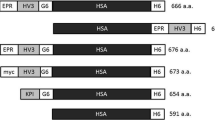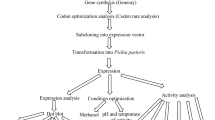Abstract
Despite the fact that lytic therapy of thromboembolic disorder has been achieved, reocclusion of the damaged vessels and bleeding complication frequently reduce the therapeutic effect. In order to prevent the vessel reocclusion and enhance the therapeutic effect, combining the anticoagulant with the thrombolytic was assumed. Herein, we propose that restraining but locally releasing anticoagulant activity in the vicinity of thrombus is a way to alleviate the bleeding risk. A bifunctional fusion protein, termed as SFH (Staphylokinase (SAK) linked by FXa recognition peptide at N-terminus of Hirudin (HV)), was designed. SFH retained thrombolytic activity but no anticoagulant activity in thrombus-free blood due to the extension of the N-terminus of HV. However, it could locally liberate intact HV and exhibit anticoagulant activity when FXa or fresh thrombus was present. At equimolar dose, both improved antithrombotic and thrombolytic effects of SFH were observed in kappa-carrageenin inducing mouse-tail thrombosis model and rat inferior vena cava thrombosis model, respectively. Moreover, we observed significantly lower bleeding risk in mice and rats treated with SFH than with the mixture of SAK and HV with monitoring TT (P < 0.01), aPTT (P < 0.05) and PT (P < 0.05), and bleeding time (P < 0.05). In conclusion, SFH is a promising bifunctional therapeutic candidate with lower bleeding risk.







Similar content being viewed by others
References
Anderson RN, Smith BL (2003) Deaths: leading causes for 2001. National Vital Statistics Reports 52:1–12
Collen D (1998) Staphylokinase: a potent, uniquely fibrin-selective thrombolytic agent. Nat Med 4:279–284
Lijnen HR, Van Hoef B, Matsuo O, Collen D (1992) On the molecular interactions between plasminogen-staphylokinase, alpha 2-antiplasmin and fibrin. Biochim Biophys Acta 1118:144–148
Ohman EM, Harrington RA, Cannon CP, Agnelli G, Cairns JA, Kennedy JW (2001) Intravenous thrombolysis in acute myocardial infarction. Chest 119:253S–277S
Vanderschueren S, Barrios L, Kerdsinchai P, Van den Heuvel P, Hermans L, Vrolix M, De Man F, Benit E, Muyldermans L, Collen D et al (1995) A randomized trial of recombinant staphylokinase versus alteplase for coronary artery patency in acute myocardial infarction. The STAR Trial Group. Circulation 92:2044–2049
Investigaors TGa (1993) The effects of tissue plasminogen activator, streptokinase, or both on coronary–artery patency, ventricular function, and survival after acute myocardial infarction. The GUSTO Angiographic Investigators. N Engl J Med 329:1615–1622
Hennekens CH, O’Donnell CJ, Ridker PM, Marder VJ (1995) Current issues concerning thrombolytic therapy for acute myocardial infarction. J Am Coll Cardiol 25:18S–22S
Tsikouris JP, Tsikouris AP (2001) A review of available fibrin-specific thrombolytic agents used in acute myocardial infarction. Pharmacotherapy 21:207–217
Vanderschueren S, Stockx L, Wilms G, Lacroix H, Verhaeghe R, Vermylen J, Collen D (1995) Thrombolytic therapy of peripheral arterial occlusion with recombinant staphylokinase. Circulation 92:2050–2057
Eccleston D, Topol EJ (1995) Inhibitors of platelet glycoprotein IIb/IIIa as augmenters of thrombolysis. Coron Artery Dis 6:947–955
Yasuda T, Gold HK, Yaoita H, Leinbach RC, Guerrero JL, Jang IK, Holt R, Fallon JT, Collen D (1990) Comparative effects of aspirin, a synthetic thrombin inhibitor and a monoclonal antiplatelet glycoprotein IIb/IIIa antibody on coronary artery reperfusion, reocclusion and bleeding with recombinant tissue-type plasminogen activator in a canine preparation. J Am Coll Cardiol 16:714–722
Rapold HJ (1990) Promotion of thrombin activity by thrombolytic therapy without simultaneous anticoagulation. Lancet 335:481–482
Gruber A, Harker LA, Hanson SR, Kelly AB, Griffin JH (1991) Antithrombotic effects of combining activated protein C and urokinase in nonhuman primates. Circulation 84:2454–2462
Zeymer U, von Essen R, Tebbe U, Niederer W, Maurer W, Vogt A, Neuhaus KL (1995) Frequency of “optimal anticoagulation” for acute myocardial infarction after thrombolysis with front-loaded recombinant tissue-type plasminogen activator and conjunctive therapy with recombinant hirudin (HBW 023). ALKK Study Group. Am J Cardiol 76:997–1001
Yao SK, McNatt J, Anderson HV, Eidt J, Cui KX, Golino P, Glas-Greenwalt P, Maraganore J, Buja LM, Willerson JT (1992) Thrombin inhibition enhances tissue-type plasminogen activator-induced thrombolysis, delays reocclusion. Am J Physiol 262:H374–H379
Markwardt F (1991) Hirudin and derivatives as anticoagulant agents. Thromb Haemost 66:141–152
Metz BK, White HD, Granger CB, Simes RJ, Armstrong PW, Hirsh J, Fuster V, MacAulay CM, Califf RM, Topol EJ (1998) Randomized comparison of direct thrombin inhibition versus heparin in conjunction with fibrinolytic therapy for acute myocardial infarction: results from the GUSTO-IIb trial. Global use of strategies to open occluded coronary arteries in acute coronary syndromes (GUSTO-IIb) investigators. J Am Coll Cardiol 31:1493–1498
Weitz JI, Buller HR (2002) Direct thrombin inhibitors in acute coronary syndromes: present and future. Circulation 105:1004–1011
Lijnen HR, Wnendt S, Schneider J, Janocha E, Van Hoef B, Collen D, Steffens GJ (1995) Functional properties of a recombinant chimeric protein with combined thrombin inhibitory and plasminogen-activating potential. Eur J Biochem 234:350–357
Wirsching F, Luge C, Schwienhorst A (2002) Modular design of a novel chimeric protein with combined thrombin inhibitory activity and plasminogen-activating potential. Mol Genet Metab 75:250–259
Szarka SJ, Sihota EG, Habibi HR, Wong S (1999) Staphylokinase as a plasminogen activator component in recombinant fusion proteins. Appl Environ Microbiol 65:506–513
Icke C, Schlott B, Ohlenschlager O, Hartmann M, Guhrs KH, Glusa E (2002) Fusion proteins with anticoagulant and fibrinolytic properties: functional studies and structural considerations. Mol Pharmacol 62:203–209
Wallace A, Dennis S, Hofsteenge J, Stone SR (1989) Contribution of the N-terminal region of hirudin to its interaction with thrombin. Biochemistry 28:10079–10084
Fortkamp E, Rieger M, Heisterberg-Moutses G, Schweitzer S, Sommer R (1986) Cloning and expression in Escherichia coli of a synthetic DNA for hirudin, the blood coagulation inhibitor in the leech. Dna 5:511–517
Peter K, Graeber J, Kipriyanov S, Zewe-Welschof M, Runge MS, Kubler W, Little M, Bode C (2000) Construction and functional evaluation of a single-chain antibody fusion protein with fibrin targeting and thrombin inhibition after activation by factor Xa. Circulation 101:1158–1164
Peter K, Gupta A, Nordt T, Bauer S, Runge MS, Bode C (2003) Construction and in vitro testing of a novel fab-hirudin-based fusion protein that targets fibrin and inhibits thrombin in a factor Xa-dependent manner. J Cardiovasc Pharmacol 42:237–244
Lian Q, Szarka SJ, Ng KK, Wong SL (2003) Engineering of a staphylokinase-based fibrinolytic agent with antithrombotic activity and targeting capability toward thrombin-rich fibrin and plasma clots. J Biol Chem 278:26677–26686
Szemraj J, Walkowiak B, Kawecka I, Janiszewska G, Buczko W, Bartkowiak J, Chabielska E (2005) A new recombinant thrombolytic and antithrombotic agent with higher fibrin affinity—a staphylokinase variant. I. In vitro study. J Thromb Haemost 3:2156–2165
Kaiser B (2002) Factor Xa–a promising target for drug development. Cell Mol Life Sci 59:189–192
Zhang ZQ, Yao LH, Hou YD (1990) Construction and application of a high-level expression vector containing PRPL promotor. Bingdu Xuebao 6:111–115
Johnson BH, Hecht MH (1994) Recombinant proteins can be isolated from E. coli cells by repeated cycles of freezing and thawing. Biotechnology (N Y) 12:1357–1360
Lowry OH, Rosebrough NJ, Farr AL, Randall RJ (1951) Protein measurement with the Folin phenol reagent. J Biol Chem 193:265–275
Saksela O (1981) Radial caseinolysis in agarose: a simple method for detection of plasminogen activator in the presence of inhibitory substances and serum. Anal Biochem 111:276–282
Schlott B, Hartmann M, Guhrs KH, Birch-Hirschfeid E, Pohl HD, Vanderschueren S, Van de Werf F, Michoel A, Collen D, Behnke D (1994) High yield production and purification of recombinant staphylokinase for thrombolytic therapy. Biotechnology (N Y) 12:185–189
Jutisz M, Martinoli G, Tertrin C (1962) Microdetermination of an anti-thrombic activity: hirudin Bull Soc Chim Biol (Paris) 44:461–469
Ohashi H, Katsuta-Enomoto Y, Yasufuku K, Okada K, Yano M (1991) Synthesis of human big endothelin-1 by sequence-specific proteolysis of a fusion protein in Escherichia coli. J Biochem (Tokyo) 110:628–634
Bekemeier H, Giessler AJ (1987) Thrombosis induction by different carrageenans in rats and mice. Naturwissenschaften 74:345–346
Bekemeier H, Hirschelmann R, Giessler AJ (1985) Carrageenin-induced thrombosis in rats and mice: a model for testing antithrombotic substances? Agents Actions 16:446–451
Hu SJ, Tian QL, Pei QY et al (1993) A new model for animal thrombosis in vivo. Chinese J Hematol 14:541–542
Elg M, Borjesson I, Carlsson S (2003) Three vehicle formulations for melagatran, a direct thrombin inhibitor, evaluated in a vena cava thrombosis model in the rat. Biopharm Drug Dispos 24:251–257
Millet J, Theveniaux J, Pascal M (1987) A new experimental model of venous thrombosis in rats involving partial stasis and slight endothelium alterations. Thromb Res 45:123–133
Monreal M, Silveira P, Monreal L, Monasterio J, Angles AM, Lafoz E, Lorente L (1991) Comparative study on the antithrombotic efficacy of four low-molecular-weight heparins in three different models of experimental venous thrombosis. Haemostasis 21:91–97
Dejana E, Villa S, de Gaetano G (1982) Bleeding time in rats: a comparison of different experimental conditions. Thromb Haemost 48:108–111
Momi S, Nasimi M, Colucci M, Nenci GG, Gresele P (2001) Low molecular weight heparins prevent thrombin-induced thrombo-embolism in mice despite low anti-thrombin activity. Evidence that the inhibition of feed-back activation of thrombin generation confers safety advantages over direct thrombin inhibition. Haematologica 86:297–302
Eisenberg PR (1991) Importance of modulating balance of procoagulant and fibrinolytic activity to success of antithrombotic therapy. Circulation 84:2601–2603
Weitz JI, Leslie B, Hudoba M (1998) Thrombin binds to soluble fibrin degradation products where it is protected from inhibition by heparin-antithrombin but susceptible to inactivation by antithrombin-independent inhibitors. Circulation 97:544–552
Badimon L, Badimon JJ, Lassila R, Heras M, Chesebro JH, Fuster V (1991) Thrombin regulation of platelet interaction with damaged vessel wall and isolated collagen type I at arterial flow conditions in a porcine model: effects of hirudins, heparin, and calcium chelation. Blood 78:423–434
Pizzo SV, Friedberg RC, Sze P, Winant R, Hudson D, Lazar JM, Johnson PH (1990) Recombinant hirudin displaces human factor Xa from its endothelial binding sites. Thromb Res 57:803–806
Betz A, Wong PW, Sinha U (1999) Inhibition of factor Xa by a peptidyl-alpha-ketothiazole involves two steps. Evidence for a stabilizing conformational change. Biochemistry 38:14582–14591
Suttie JW, Geweke LO, Martin SL, Willingham AK (1980) Vitamin K epoxidase: dependence of epoxidase activity on substrates of the vitamin K-dependent carboxylation reaction. FEBS Lett 109:267–270
Bekemeier H, Hirschelmann R, Giessler AJ (1984) Carrageenin-induced thrombosis in the rat and mouse as a test model of substances influencing thrombosis. Biomed Biochim Acta 43:S347–S350
Acknowledgments
The authors thank Professors Zhonghua Jiang, Yuanmin Li, Zhongxiong Tang and Lizhen Yuan for their fruitful advice and discussions. This work was supported by China Postdoctoral Science Foundation, 2002032086.
Author information
Authors and Affiliations
Corresponding authors
Rights and permissions
About this article
Cite this article
Shi, B., Yu, A., Liu, Y. et al. Locally activity-released bifunctional fusion protein enhances antithrombosis and alleviates bleeding risk. J Thromb Thrombolysis 24, 283–292 (2007). https://doi.org/10.1007/s11239-007-0036-6
Received:
Accepted:
Published:
Issue Date:
DOI: https://doi.org/10.1007/s11239-007-0036-6




